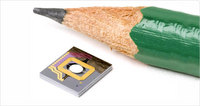Energy Harvesting, MEMS Based Fuel Cells and Low Power ICs
WHAT IS MEMS?
Courtesy MEMSNET
Micro-Electro-Mechanical Systems (MEMS) is the integration of mechanical elements, sensors, actuators, and electronics on a common silicon substrate through microfabrication technology. While the electronics are fabricated using integrated circuit (IC) process sequences (e.g., CMOS, Bipolar, or BICMOS processes), the micromechanical components are fabricated using compatible "micromachining" processes that selectively etch away parts of the silicon wafer or add new structural layers to form the mechanical and electromechanical devices.
MEMS promises to revolutionize nearly every product category by bringing together silicon-based microelectronics with micromachining technology, making possible the realization of complete systems-on-a-chip. MEMS is an enabling technology allowing the development of smart products, augmenting the computational ability of microelectronics with the perception and control capabilities of microsensors and microactuators and expanding the space of possible designs and applications.
Microelectronic integrated circuits can be thought of as the "brains" of a system and MEMS augments this decision-making capability with "eyes" and "arms", to allow microsystems to sense and control the environment. Sensors gather information from the environment through measuring mechanical, thermal, biological, chemical, optical, and magnetic phenomena. The electronics then process the information derived from the sensors and through some decision making capability direct the actuators to respond by moving, positioning, regulating, pumping, and filtering, thereby controlling the environment for some desired outcome or purpose. Because MEMS devices are manufactured using batch fabrication techniques similar to those used for integrated circuits, unprecedented levels of functionality, reliability, and sophistication can be placed on a small silicon chip at a relatively low cost.
1st Annual Workshop on Micro Power Technologies
October 22, 2009
8AM -- 5PM
Radisson Hotel
San Jose, CA
MEMS Investor Journal and MEPTEC, the MicroElectronics Packaging and Test Engineering Council, will hold the 1st Annual Workshop on Micro Power Technologies on October 22, 2009 at the Radisson Hotel, San Jose, CA.
Space is limited -- register today!
http://www.micropowertech2009.com/
https://meptec.org/micropowertechno.html
Gold Sponsor
Tegal Corporation
http://www.tegal.com
The program for this workshop has been finalized:
MEMS Based Fuel Cell Systems: Progress, Challenges and Advantages for Portable Power
Jeff Morse, Ph.D., Managing Director
National Nanomanufacturing Network
Market Prospects for Micro Power Technologies
Jérémie Bouchaud, Director and Principal Analyst, MEMS
iSuppli
Energy Harvesting Systems Using Piezo-Electric Macro Fiber Composites
Thomas Daue, President
Smart Material Corporation
Utilizing Waste Energy for Wireless Sensor Networks, for Better System Control and Maintenance Plans
Bernd Krafthoefer, America Sales Manager
Micropelt
Combining Energy Harvesting and Power Management for a Wireless Sensor Power Solution
Charles Lakeman, Vice President Micropower Division
TPL Inc.
Fuel Flexible Micro Wankel Power System Project -- Fuel Flexible Mini and Micro Engines
Dr. Albert ("Al") P. Pisano, Professor and Chair, Department of Mechanical Engineering
University of California at Berkeley
Energy Harvesting for Tire Pressure Monitoring Systems
Dr. Shad Roundy, Senior Manager, Sensor Engineering
Atmel
Advances in Vibration Energy Harvesting - A Market, Application and Technology Update
Jerry Ruddle, Executive Vice President and General Manager, Commercialization
Advanced Cerametrics, Inc.
An Overview of Battery Technologies for Energy Harvesting Applications
David Squires, VP Strategic Marketing
Infinite Power Solutions
Please go to http://www.micropowertech2009.com for complete program details, presentation abstracts, speaker bios and registration information.
Space is limited -- register today!
http://www.micropowertech2009.com/
https://meptec.org/micropowertechno.html
Sponsorship opportunities are also available; please click here for information.
http://www.micropowertech2009.com/#SponsorOpps
On the prior day, October 21, MEPTEC and MEMS Investor Journal will hold another event, the 2nd Annual Workshop on MEMS Testing and Reliability.
MEMS and Nanotechnology Applications
Courtesy MEMSNET
There are numerous possible applications for MEMS and Nanotechnology. As a breakthrough technology, allowing unparalleled synergy between previously unrelated fields such as biology and microelectronics, many new MEMS and Nanotechnology applications will emerge, expanding beyond that which is currently identified or known. Here are a few applications of current interest:
Biotechnology
MEMS and Nanotechnology is enabling new discoveries in science and engineering such as the Polymerase Chain Reaction (PCR) microsystems for DNA amplification and identification, micromachined Scanning Tunneling Microscopes (STMs), biochips for detection of hazardous chemical and biological agents, and microsystems for high-throughput drug screening and selection.
Communications
High frequency circuits will benefit considerably from the advent of the RF-MEMS technology. Electrical components such as inductors and tunable capacitors can be improved significantly compared to their integrated counterparts if they are made using MEMS and Nanotechnology. With the integration of such components, the performance of communication circuits will improve, while the total circuit area, power consumption and cost will be reduced. In addition, the mechanical switch, as developed by several research groups, is a key component with huge potential in various microwave circuits. The demonstrated samples of mechanical switches have quality factors much higher than anything previously available.
Reliability and packaging of RF-MEMS components seem to be the two critical issues that need to be solved before they receive wider acceptance by the market.
Accelerometers
MEMS accelerometers are quickly replacing conventional accelerometers for crash air-bag deployment systems in automobiles. The conventional approach uses several bulky accelerometers made of discrete components mounted in the front of the car with separate electronics near the air-bag; this approach costs over $50 per automobile. MEMS and Nanotechnology has made it possible to integrate the accelerometer and electronics onto a single silicon chip at a cost between $5 to $10. These MEMS accelerometers are much smaller, more functional, lighter, more reliable, and are produced for a fraction of the cost of the conventional macroscale accelerometer elements.
MEMS Investor Journal | 2222 Fuller Court | Ann Arbor | MI | 48105




